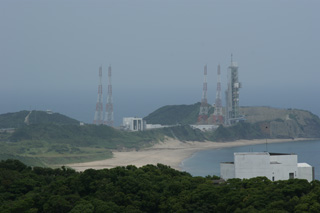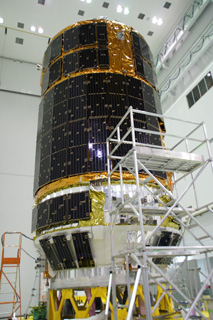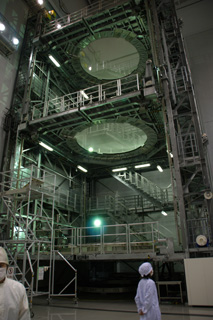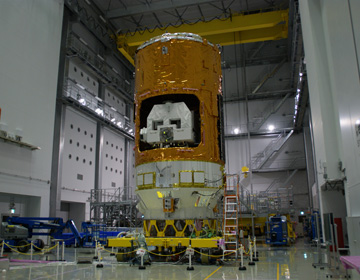 |
About JAXA, Japan Aerospace Exploration AgencyOn September 11, 2009, the news of the successful launch of an H-IIB testing rocket, equipped with a machine to verify the technology of an HII transfer vehicle (HTV), from Tanegashima Space Center was reported throughout Japan. This is still vivid in our memory. Japan Aerospace Exploration Agency or JAXA must be a place where the essence of Japanese technology is gathering. What is it like? We gained special permission from Tanegashima Space Center to cover a story about the HTV before its launch. |
HTV, HII transfer vehicleFinally, Nakata saw HTV, the reason for his visit. It is 10 meters in overall length and 4.4 meters in diameter, almost as large as a large-sized bus. The HTV is larger than a conventional satellite. Many years of the project was spent on such activities as deliberating and constructing the building for assembly and maintenance, and planning the range of travel. HTV is said to be the culmination of space exploration technologies in Japan such as space transportation, navigation guidance and manned environmental control. Here, food, clothes, experimental devices and other supplies are sent from Earth to the International Space Station. |
 |
 |
Dreaming about spaceHumankind’s aspiration and quest for space will not end. It has remained unchanged after Gagarin succeeded in the first-ever manned space flight in 1961. At JAXA, numerous projects have been planned for and after 2010. Akatsuki (PLANET-C), a Venus probe scheduled to be launched in 2010, will arrive at the orbit around Venus within a half year after launch, and will spend about two years studying the atmosphere of Venus. JAXA is looking for messages to be sent by Akatsuki along with the names of the persons who provide them. |
ACCESS
- Japan Aerospace Exploration Agency (JAXA)
- Mazu, Kukinaga, Minamitane-cho, Kumage-gun, Kagoshima
- URL http://global.jaxa.jp/
 Discovering Japan [Nihon] through authentic craftsmanship [Honmono]
Discovering Japan [Nihon] through authentic craftsmanship [Honmono]